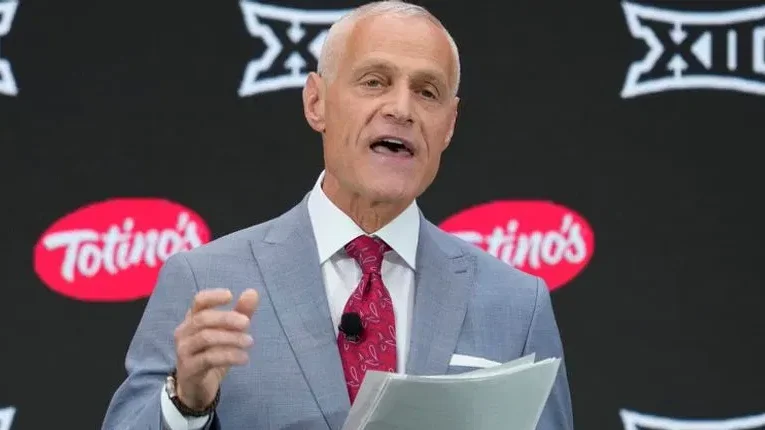The landscape of college football stands at a crossroads as conference commissioners wrestle with the sport’s postseason future.
While the 12-team playoff format is set for 2025, intense negotiations continue over what comes next, with a December 1 deadline looming for decisions about the 2026 season and beyond.
Big 12 Commissioner Brett Yormark has emerged as a vocal advocate for a 5+11 model that would grant automatic qualifying spots to five conference champions, with 11 at-large bids completing the field.
This stance puts him at odds with an alternative proposal that would give the SEC and Big Ten four automatic qualifiers each.
“We want to earn it on the field,” Yormark said during the Big 12 spring meetings in Orlando. “The 5-11 might not be ideal for the conference, but it’s good for college football, and it’s what’s fair. We don’t want any gimmes.”
The debate has exposed deeper fault lines in college football’s power structure.
The SEC and Big Ten, following their expansion moves, hold unprecedented influence over the sport’s future.
Yet this authority comes with increased scrutiny from other conferences and stakeholders who worry about competitive balance.
TCU coach Sonny Dykes offered a pointed critique of proposals favoring certain conferences with multiple automatic bids.
“That’s not how it works in pro football, that’s not how it works in any other sport,” Dykes said. “The AFC West gets four bids, and the NFC Central only gets two, that stuff doesn’t make sense. It’s not good for the sport.”
The tension between conferences reached a new level when SEC commissioner Greg Sankey responded to suggestions about protecting the sport’s broader interests.
“I don’t need lectures from others about ‘good of the game,'” Sankey said, highlighting the increasingly fractious nature of these discussions.
Arizona State coach Kenny Dillingham, whose team made the playoff last season, emphasized the importance of maintaining competitive opportunity.
“Every year is a new year,” he said. “You never know who’s going to be good in college football, especially with the volatility with the portal. So anything that creates an open platform for teams to prove that they belong, I’m in support of.”
The timing pressure adds another layer of complexity.
Conference commissioners and Notre Dame athletics director Pete Bevacqua are scheduled to meet June 18 in Asheville, N.C., to continue format discussions.
This meeting represents a crucial step toward reaching consensus before the December deadline.
Financial implications loom large over these negotiations.
The new television contracts starting in 2026 will significantly increase revenue distribution, particularly for the SEC and Big Ten.
These conferences must balance their enhanced market power with maintaining the collegiate model’s competitive integrity.
The debate extends beyond just playoff access.
Questions about regular-season scheduling, conference game requirements, and the overall structure of the sport remain unresolved.
The SEC currently plays eight conference games while the Big Ten plays nine, creating another point of contention in determining fair playoff access.
Industry experts suggest the final format will likely require compromise from all parties.
The 5+11 model has gained traction partly because it preserves merit-based access while acknowledging the sport’s competitive hierarchy.
It would ensure opportunities for emerging programs while maintaining high standards for playoff qualification.
Despite the current disagreements, Yormark remains optimistic about reaching a resolution.
“We’re going to battle,” he said. “That’s part of life. We’re going to agree to disagree. We’re kind of in that mode right now, but I have a lot of respect for my peers, and I know they have a lot of respect for me and Jim, and we’ll end up in the right place.”
With billions of dollars and the competitive balance of college football at stake, finding common ground has never been more crucial.
But, as has always been the case in college athletics, follow the money. The answers are probably at the end.

